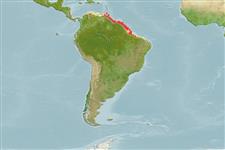Common names from other countries
Environment: milieu / climate zone / depth range / distribution range
Écologie
marin; saumâtre démersal; profondeur 10 - ? m (Ref. 5217). Tropical; 13°N - 9°S
Western Atlantic: West Indies and the Atlantic coasts of Central and South America to southeastern Brazil.
Length at first maturity / Taille / Poids / Âge
Maturity: Lm ?, range 24 - ? cm
Max length : 40.0 cm TL mâle / non sexé; (Ref. 3791); 35.0 cm TL (female); common length : 25.0 cm TL mâle / non sexé; (Ref. 5217)
Mainly found in brackish estuaries but also in marine and hyper-saline waters (Ref. 5217). During reproduction, they gather in small groups at the mouth of coastal rivers and creeks. Reproduction occurs in the early part of the year. Oviparous, eggs are pelagic and non-adhesive (Ref. 205). Eggs which are rich in yolk are spawned by the millions. Upon hatching, juveniles move up to the swamps and coastal rivers over long distances, to seek for food and to protect themselves against predators (Ref. 35237). Marketed fresh or salted (Ref. 5217). The roe is marketed salt-pickled and dried and considered a delicacy (Ref. 5217).
Life cycle and mating behavior
Maturities | Reproduction | Spawnings | Egg(s) | Fecundities | Larves
Spawning seems to take place in small groups in river mouths. Females lay millions of relatively large eggs rich in yolk.
Thomson, J.M., 1978. Mugilidae. In W. Fischer (ed.) FAO species identification sheets for fishery purposes. Western Central Atlantic (Fishing Area 31). Vol. 3. [pag. var.]. FAO, Rome. (Ref. 3791)
Statut dans la liste rouge de l'IUCN (Ref. 130435)
CITES (Ref. 128078)
Not Evaluated
Menace pour l'homme
Harmless
Utilisations par l'homme
Pêcheries: intérêt commercial mineur
Outils
Articles particuliers
Télécharger en XML
Sources Internet
Estimates based on models
Preferred temperature (Ref.
115969): 26.7 - 28.1, mean 27.4 (based on 46 cells).
Phylogenetic diversity index (Ref.
82804): PD
50 = 0.5000 [Uniqueness, from 0.5 = low to 2.0 = high].
Bayesian length-weight: a=0.00977 (0.00595 - 0.01605), b=2.91 (2.78 - 3.04), in cm Total Length, based on LWR estimates for this species & Genus-body shape (Ref.
93245).
Niveau trophique (Ref.
69278): 2.0 ±0.1 se; based on diet studies.
Résilience (Ref.
120179): Haut, temps minimum de doublement de population inférieur à 15 mois (Preliminary K or Fecundity.).
Fishing Vulnerability (Ref.
59153): Low vulnerability (24 of 100).
